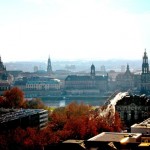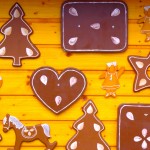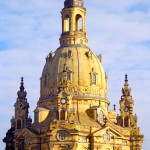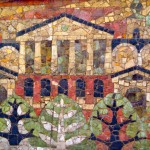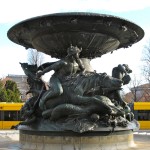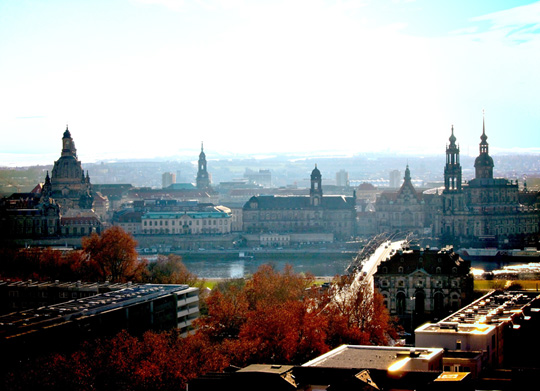
In the first weekend of December, two small groups from ECLA of Bard left the German capital to visit Dresden. The first group, lead by Prof. Florian Becker and Prof. Aya Soika, visited the city as part of their Berlin: Experiment in Modernity, starting on Friday, November 31st. The second group, initiated by ECLA of Bard’s Residential Life Coordinator Zoltan Helmich, followed a day later.
Dresden is located approximately 125 kilometers south-east of Berlin and is the capital of the Free State of Saxony, which borders with the Czech Republic. As part of the second group from ECLA of Bard, I arrived in Dresden on the morning of Saturday, December 1st. We had taken the train a few hours earlier, and before I knew it, the skyline of Berlin had been replaced by that of Dresden. I remember my first impression upon arrival: the train station, I thought, was smaller than Berlin’s central station (Berlin Hauptbahnhof), but definitely larger than the train station of the only other German city I had traveled to – Leipzig. As a matter of fact, as we walked down the streets of Dresden, everything – from the size of the streets to the architecture – seemed larger than in Leipzig.
Which, of course, meant there was a lot to see. Luckily, it happened to be a clear, although rather cold, winter day. Dresden had seen its first snowfall a few days earlier, which added to the festive atmosphere when my group arrived at the first destination – the large Christmas Market. Having never seen a Christmas Market at that time, I was absolutely fascinated by the small booths offering hand-made crafts, delicious candy, and freshly prepared food and drinks. And although it was morning, the market was already bursting with energy.
Having warmed ourselves up with some delicious hot chocolate (that is, real melted chocolate in waffle cups), my group and I continued our tour around town, passing the famous protestant church Frauenkirche, the Catholic Cathedral Katholische Hofkirche with the crypt of the Wettin dynasty of Saxony, Kreuzkirche, the oldest church in Dresden, another two Christmas Markets, and the beautiful sister fountains Stille Wasser und Stürmische Wogen (Still Waters and Stormy Waves). Our next stop was yet another church, the Drei Königs Kirche, which is one of the tallest in Dresden – from its tower, we were able to see the whole city.
Our final major destination was the Gemäldegalerie Alte Meister (Old Masters Gallery), part of the Staatliche Kunstsammlungen Dresden (Dresden State Art Collection) and housed in the beautiful Zwinger Palace. There I was able to witness a variety of 15th-18th century paintings, among which Raphael’s Sistine Madonna, Jean-Étienne Liotard’s The Chocolate Girl, works by Johannes Vermeer (such as Girl Reading a Letter at an Open Window), Hans Holbein the Younger, and Jan van Eyck – paintings I had grown up reading about and seeing pictures of, but never even dreamed of actually seeing live!
Having seen these wonders, my group and I departed, for we had chosen to stay only for the day. The other group, on the other hand, stayed for the whole weekend. We only met briefly on two occasions on that Saturday, as they were on their way to museums and galleries. I later spoke with my classmates from the Berlin class, yearning to hear what else they had seen. I was surprised to learn that, despite the time difference between the two groups’ stays in Dresden, the places we had visited had coincided to a great extent.
The first group had begun their visit with a guided tour of the Bundeswehr Military History Museum on Saturday morning. What surprised me the most was learning that the museum, which is one of the biggest military history museums in Germany, had been recently renovated by no other than the architect of the Jewish Museum in Berlin – Daniel Libeskind.
Next, the Berlin class group went to visit Frauenkirche, the Christmas Markets, the Gemäldegalerie Alte Meister, the Staatliche Naturhistorische Sammlungen Dresden (State Collection of Natural History Dresden), The Universitätssammlung Kunst + Technik (Collection of Art and Technology of the Dresden University of Technology), and the Grünes Gewölbe (Green Vault), which is literally a treasure vault, holding an incredible collection of world treasures, among which there currently is a guest exhibit of treasures from the Kremlin. The group returned to Berlin on Sunday evening, spending a day more than us at Dresden.
Thus, in two days’ time, a small portion of ECLA of Bard saw a large portion of the capital of the Free State of Saxony. Dresden has even more treasures that are waiting to be explored: from the Galerie Neue Meister (New Masters Gallery), which has pieces by Van Gogh, Monet, and Degas, to the incredible Sächsische Staatskapelle Dresden (Saxon State Orchestra, Dresden), where operas by Wagner and Strauss, among others, saw their very first performances.
If you ever wish to visit Dresden, plan to spend at least a week in this incredible city of history, architecture and treasures. I assure you, you will not be disappointed.

